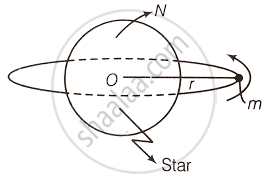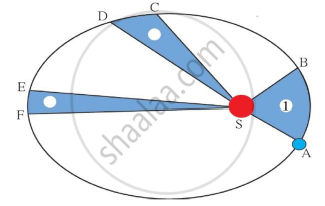Advertisements
Advertisements
प्रश्न
A star like the sun has several bodies moving around it at different distances. Consider that all of them are moving in circular orbits. Let r be the distance of the body from the centre of the star and let its linear velocity be v, angular velocity ω, kinetic energy K, gravitational potential energy U, total energy E and angular momentum l. As the radius r of the orbit increases, determine which of the above quantities increase and which ones decrease.
उत्तर
The situation is shown in the diagram, where a body of mass m is revolving around a star of mass M.

Linear velocity of the body `v = sqrt((GM)/r)`
⇒ `v ∝ 1/sqrt(r)`
Therefore, when r increases, v decreases.
Angular velocity of the body `ω = (2π)/T`
According to Kepler's law of the period,
`T^2 ∝ r^3` ⇒ `T = kr^(3/2)`
Where k is a constant
∴ `ω = (2π)/(kr^(3/2))` ⇒ `ω ∝ 1/r^(3/2)` .....`(∵ ω = (2π)/T)`
Therefore, when r increases, ω decreases.
The kinetic energy of the body,
K = `1/2 mv^2`
= `1/2 m xx (GM)/r`
= `(GMm)/(2r)`
∴ `K ∝ 1/r`
Therefore, when r increases, KE decreases.
The gravitational potential energy of the body,
`U = - (GMm)/r` ⇒ `U ∝ 1/r`
Therefore, when r increases, PE becomes less negative i.e., increases.
Total energy of the body,
`E = KE + PE`
= `(GMm)/(2r) + (- (GMm)/r)`
= `- (GMm)/(2r)`
Therefore, when r increases, total energy becomes less negative, i.e., increases.
Angular momentum of the body,
`L = mvr`
= `mr sqrt((GM)/r)`
= `msqrt(GMr)`
∴ `L ∝ sqrt(r)`
Therefore, when r increases, angular momentum L increases.
APPEARS IN
संबंधित प्रश्न
State Kepler's law of orbit and law of equal areas.
A comet orbits the Sun in a highly elliptical orbit. Does the comet have a constant (a) linear speed, (b) angular speed, (c) angular momentum, (d) kinetic energy, (e) potential energy, (f) total energy throughout its orbit? Neglect any mass loss of the comet when it comes very close to the Sun.
Identify the law shown in the figure and state three respective laws.

The orbit of a planet revolving around a star is _______.
Write the Kepler's laws.
To verify Kepler's third law graphically four students plotted graphs. Student A plotted a graph of T (period of revolution of planets) versus r (average distance of planets from the sun) and found the plot is straight line with slope 1.85. Student B plotted a graph of T2 v/s r3 and found the plot is straight line with slope 1.39 and negative Y-intercept. Student C plotted graph of log T v/s log r and found the plot is straight line with slope 1.5. Student D plotted graph of log T v/s log r and found the plot is straight line with slope 0.67 and with negative X-intercept. The correct graph is of student
If the sun and the planets carried huge amounts of opposite charges ______.
- all three of Kepler’s laws would still be valid.
- only the third law will be valid.
- the second law will not change.
- the first law will still be valid.
Draw areal velocity versus time graph for mars.
What is the direction of areal velocity of the earth around the sun?
A satellite is in an elliptic orbit around the earth with aphelion of 6R and perihelion of 2 R where R= 6400 km is the radius of the earth. Find eccentricity of the orbit. Find the velocity of the satellite at apogee and perigee. What should be done if this satellite has to be transferred to a circular orbit of radius 6R ?
[G = 6.67 × 10–11 SI units and M = 6 × 1024 kg]
